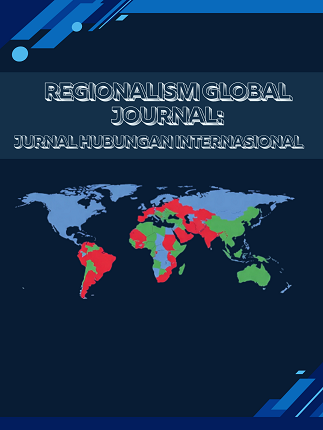
AUTHOR GUIDLINES
|
This manuscript is written in Indonesian, including the results of research, field research or literary research and articles that reflect social phenomena. |
|
TITLE The title should not exceed 14 words; It should be clear, concise, and informative. Abbreviations should be avoided. |
|
Author's name The author's name is written without an academic degree, followed by the name of the author's institution, which is located under the title of the article. In the case of a script written by a team, the editor only deals with the main or previously mentioned author. The lead author must include his or her correspondence or email address. |
|
Abstract with keywords The length of the abstract is about 200-250 words, while the keyword limit is 3-5 words. The abstract, at a minimum, should contain the objectives, methods, and results of the research. |
|
INTRODUCTION The introduction should contain (in order) general background and research questions or hypotheses. If there is a literature review, it can be included in this chapter. The research objective should be written at the end of the introduction. |
|
METHOD The research method should outline the methods used in solving the problem including the method of analysis. Contains sufficient detail to allow the reader to evaluate the suitability of the method as well as the reliability and validity of the findings. |
|
RESULTS AND DISCUSSION The author must explain the results of the research (what was found) in detail. The results of the research and the discussion section contain the results of research findings and subsequent discussions. Findings obtained from the results of the research conducted must be written with adequate additional data support. The results and findings of the research must be able to complete or provide an explanation of the questions outlined in the introduction. |
|
CONCLUSION The closing statement should contain a summary and suggestions. The summary should exemplify the answers given to the hypothesis and/or research objectives or findings obtained. The summary should not contain a repetition of the results of the research and discussion, but rather should contain a summary of the research results and findings as expected in the research objectives or hypotheses. Suggestions should present things that will be done next in relation to the next research concept. |
|
REFERENCES All references cited in the text of the article should be written in the bibliography section. Must include references obtained from primary sources (comprising 80% of the total bibliography) that have been published in the last 10 (ten) years. The remaining 20% can include research articles or research reports (theses, books, and other related publications. All references mentioned should be written in references using the American Psychological Association (APA) style and arranged from A to Z. |
|
Manuscripts must be sent directly to https://e-journals2.unmul.ac.id/index.php/RGJ by creating a user account as an author. |
|
Books with a single author Reference: Amirudin, (2006). Pengantar Metode Penelitian Hukum. Rajawali Pers. In text: (Amirudin, 2006) |
|
Books with two authors Reference: Creswell, J. W., & Poth, C. N. (2018). Qualitative Inquiry & Research Design: Choosing among Five approaches. SAGE Publications. In text: (Creswell & Poth, 2018) |
|
Books with three or more authors Reference: Dwee, D., Dion, H. B., & Brown, I. S. (2012). Information behaviour concept: A basic introduction. University of Life Press. In text: (Dwee et al., 2012) |
|
Chapter or Article in Edited Book Reference: Hermann, M. G. (2008). Content Analysis. In A. Klotz & D. Prakash (Eds.), Research methods series. Qualitative methods in international relations (pp. 151–167). Palgrave Macmillan. In text: (Hermann, 2008) |
|
Journal Article with DOI Reference: Kusumaningrum, D. (2016). Interdependence versus truth and justice: lessons from reconciliation processes in Maluku. Jurnal Ilmu Sosial dan Ilmu Politik, 20(1), 34-49. https://doi.org/10.22146/jsp.17998 In text: (Kusumaningrum, 2016) |
|
Journal Articles with URL Reference: Sudiar, S. (2019). A Human Security Approach in the Study of State Borders. Journal of International Relations, 7(2), 152-160. In text: (Ahmann, 2018) |
|
Newspaper articles Reference: Fung, M. (2006, December 12). Asthma rates increasing. Winnipeg Free Press, pp. C4. In text: (Fung, 2006) |
|
Newspaper articles with URLs Reference: Harris, M. (2011, August 16). Grades improve if classes start later, studies find. The Calgary Herald.Herald. http://www.calgaryherald.com In text: (Harris, 2011) |
|
Internet Site Reference: Buzan, T. (2007). Mind maps. http://www.buzanworld.com/Mind_Maps.ht In text: (Buzan, 2007) |
|
Book translations Reference: Mancusa, S., & Viola, A. (2015). Hijau cemerlang: Sejarah dan ilmu kecerdasan tanaman yang mengejutkan (J. Benham, Trans.). Washington, DC: Island Press. In Text: (Mancusa & Viola, 2015) |
|
Unpublished Thesis Reference: Neo, MC (2000). Peran pendidikan sebagai proses pelepasan manusia dari berbagai masalah kehidupan [Skripsi M.Appl.Psy. yang tidak diterbitkan]. Universitas Kehidupan. In text: (Neo, 2000) |
|
Published Thesis Reference: May, B. (2017). A survey of radial velocities in the zodiacal dust cloud. Canopus Publishing. In text: (May, 2017) |
|
All manuscripts are sexpertise. Authors are given the opportunity to revise the manuscript based on the reviewer's or editor's recommendations/suggestions. The decision to publish or reject will be informed via the author's email address. |


